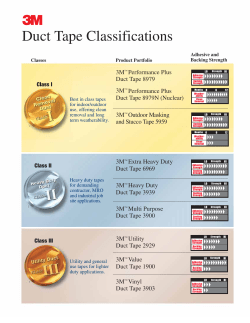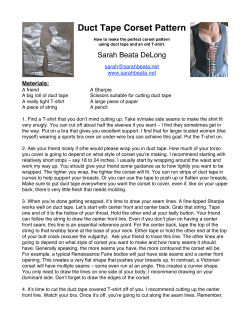
How to make a duct traversal airflow measurement
How to make a duct traversal airflow measurement Application Note Why traverse Conducting a duct traverse Proper air flow within HVAC ducts is essential to good equipment performance. When air flows are incorrect, the air can’t be conditioned as designed, operating costs are elevated, and equipment life expectancy is shortened. Many circumstances warrant measuring air velocities or air flow, and a duct traverse is the most precise method of obtaining that information. A duct traverse consists of a number of regularly spaced air velocity and pressure measurements throughout a cross sectional area of straight duct (see Figure 1). This application note explains how to do that. For maximum airflow accuracy, take several readings across a traverse plane, convert them to velocity, and then average them. The illustration in Figure 1 shows the points along the traverse plane where you should take the measurements, in either rectangular or circular ducts. Take airflow measurements at a minimum of 25 points, regardless of duct size. • For duct sides shorter than 30”, five traversal points must be taken (5 on each side, 5*5=25). • For duct sides of 30 through 36”, six points must be taken. • For duct sides longer than 36”, seven points must be taken. • If the duct side is less than 18”, then any readings you take should be taken from the center of equal areas that are no more than 6” apart, with a minimum of two points per side of the duct. The preferred location of the traverse in a supply duct should be in a straight section of duct with 10 straight equivalent duct diameters upstream, and 3 straight equivalent duct diameters downstream of the traverse plane, although a minimum of 5 duct equivalent diameters upstream and 1 duct equivalent diameter downstream may give adequate results. When the traverse is located close to the fan, flow conditions are usually more favorable upstream on the return side. The traverse on the upstream side should be 0.5 duct equivalent diameters upstream of the fan inlet. Equivalent duct diameter = √ (4HV/π) H = horizontal duct dimension V = vertical duct dimension π = 3.14 From the Fluke Digital Library @ www.fluke.com/library Inserting the measuring device To determine the insertion depth of the measuring device, reference the following tables. Let’s assume we have a sample duct with sides measuring 24” x 15”. For the 24” side of our sample rectangular duct, reference the “5 traverse lines” row. Log-Tchebycheff Rule for rectangular ducts Number of points or traverse lines Position relative to inner wall 5 0.074, 0.288, 0.500, 0.712, 0.926 6 0.061, 0.235, 0.437, 0.563, 0.765, 0.939 7 0.053, 0.0203, 0.366, 0.500, 0.634, 0.797, 0.947 Log-Tchebycheff Rule for circular ducts Number of points per diameter Position relative to inner wall 6 0.032, 0.135, 0.321, 0.679, 0.865, 0.968 8 0.021, 0.117, 0.184, 0.345, 0.655, 0.816, 0.883, 0.981 10 0.019, 0.153, 0.217, 0.361, 0.639, 0.783, 0.847, 0.923, 0.981 Note the five multipliers listed under “Position Relative to Inner Wall.” Multiply the duct dimension (24”) by the numbers in the table to arrive at the various insertion depths for that side of the duct. For example, the position closest to the inner wall would be: 0.074 * 24” = 1.78”, and so on. For the 15” side, follow the text instructions above for taking measurements when duct sides are less than 18”. Step-by-Step Here’s how to take the velocity and pressure measurements, using a Fluke 922 • Connect the total pressure tube to the 922 “+” port, and connect the static pressure tube to the “-” port. • Select “Flow Volume” mode • Select either round or rectangular duct • Enter inside duct dimensions as prompted • Zero meter • Position the Pitot-Static tube tip within the duct at the first traverse point. • When a stable air volume reading is displayed, press “Save” to store the reading. • Repeat for each traverse point • After all traverse point readings have been saved, press “Calc Average” for average airflow Total pressure minus static pressure equals velocity pressure. The Fluke 922 converts velocity pressure to velocity automatically when in Velocity mode. In Flow Volume mode, the 922 will prompt for duct geometry and dimensions in order to display air flow (cfm) directly in real time. The 922 velocity and air flow calculations are based on standard air at 29.92” hg at 70° F. Tips When we talk about positioning the pitot tube 10 straight duct diameters upstream and 3 straight duct diameters downstream of the tranverse plane, we need to first convert rectangular duct measurements into their equivalent circular diameters. To perform a traversal with circular duct, essentially follow the same traversal plane placement rules used with rectangular. However, circular ducts require measuring across 3 diameters (Figure 1), with a minimum of 6 measurements per diameter. Multiply the number of points you’ll measure with the figure in the second half of table 1 to determine the measuring position relative to the inner wall of the duct. Notes: 1. When performing a duct traverse, always ensure the nose of the Pitot tube is parallel to the duct wall and facing the airflow. 2. Take readings in long, straight runs of duct, where possible. Avoid taking readings immediately downstream of elbows or other obstructions in the airway. 2 Fluke Corporation How to make a duct traversal airflow measurement Additional resources 0.500 D 0.288 D 0.074 D 0.712 D 0.926 D Start by reviewing the ASHRAE 111 “Practices for Measurement,Testing, Adjusting, and Balancing of Building Heating, Ventilation, Air-Conditioning, and Refrigeration Systems” and ISO 3966 standards. The former includes a general chapter on air measurements, citing the LogTchebycheff rule developed in ISO 3966, in addition to further guidance on placement of the traverse plane and measuring techniques. The ISO standard goes into greater detail on the development of the rule. For more information on airflow, reference the Fluke Airflow Quick Reference Guide, # 2806211, on www.fluke.com. For a simple and concise explanation of airflow measurements, reference “Airflow in Ducts” by Leo A. Meyer (LAMA Books). 0.061 D 0.235 D 0.437 D 0.563 D 0.765 D 0.939 D 0.032 D 0.135 D 0.321 D 0.679 D 0.865 D 0.968 D D Figure 1. Measuring points and traverse lines for rectangular and circular ducts. Fluke.Keeping your world up and running.® Fluke Corporation PO Box 9090, Everett, WA USA 98206 Fluke Europe B.V. PO Box 1186, 5602 BD Eindhoven, The Netherlands For more information call: In the U.S.A. (800) 443-5853 or Fax (425) 446-5116 In Europe/M-East/Africa +31 (0) 40 2675 200 or Fax +31 (0) 40 2675 222 In Canada (800)-36-FLUKE or Fax (905) 890-6866 From other countries +1 (425) 446-5500 or Fax +1 (425) 446-5116 Web access: http://www.fluke.com ©2007 Fluke Corporation. Specifications subject to change without notice. Printed in U.S.A. 11/2007 3214678 A-EN-N Rev A 3 Fluke Corporation How to make a duct traversal airflow measurement
© Copyright 2025





















